‘Retarded Learner’: John Archibald Wheeler Still Grapples With the Universe
Editor’s note: This title and story from 1985 contains dated language that is no longer used today. In the interest of keeping a historical record, it appears here as it was originally published.
IN THE FALL OF 1983 I audited one of the most remarkable and idiosyncratic courses I have ever encountered . Open only to graduate students in physics, it was called " Foundation Problems of Physics, " and the professor was John Archibald Wheeler, then (like me) an I.I. Rabi Visiting Professor at Columbia University. Although 72 at the time, Wheeler was also and still is director of the Center for Theoretical Physics at the University of Texas in Austin. On the odd days when he was not teaching his course in New York, he was in Texas administering the center's six faculty members, twelve graduate students, six staff members, and a generous assortment of visitors from all over the world.
A compact and youthful-looking man, Wheeler partly attributes his energy to the fact that he swims a quarter of a mile a day, in a small enclosed pool by his home in Texas. In any event, he recently told me that while he liked the title of the course very much a title that had been invented by Gerald Feinberg, then chairman of Columbia's Physics Department-it gave little guidance; he had no very precise notion of how to go about teaching the course.
"Halfway through the first hour, " he recalls, " I got this idea. " Why not ask each of the 20-odd students to turn in one summary sentence from the previous lecture and one " pregnant question"? Wheeler studied these carefully and in the next class handed out mimeographed sheets with everyone's two contributions and his own responses. What follows are a few of the less technical of these exchanges:
STUDENT: Why did the “big bang” occur?
WHEELER: Physicists’ standard way to avoid misunderstanding of the word “why”: translate to, How did it come about that there was a “big bang”? A wonderful question, worthy of thought every day.
STUDENT: Where is the barrier between solipsism and objective reality in a physical theory?
WHEELER: The Los Angeles girl locked from babyhood to age 13 (when neighbors found out and called the police) in an attic room, given food but never spoken to, had by that time lost the power, not merely to speak, but even to think. There is not a word we utter, a concept we use, an idea we form, that does not directly or indirectly depend on the larger community for its existence. “Meaning”—and what else is “objective reality” if it is not meaning?—“is the joint product of those who communicate.”
Einstein: world “out there independent of any observer.”
Solipsism: “I’m the only observer who ever counts.”
“Meaning circuit”: Meaning, reality, both tied to existence of community.
STUDENT: Does the similarity between different equations of physics mean the consistency of the physicist's picture of the world (which is exciting to us) or merely the heredity of physical ideas (which is less exciting)?
WHEELER: I am too stupid to know how to analyze this question.
Wheeler thrives on students, and he enjoyed his Columbia course so much h he repeated it in Austin. He once remarked to me, "I am one of those retarded learners ... one of those people who can't learn except by teaching." He has an unusual lecture style. It features diagrams that appear to grow organically as the lecture proceeds. One has the feeling that they will continue to evolve on their own after everyone has left the room. They are both enormously dense and very clear.
Wheeler thinks, and has always thought, in a pictorial way. When he was a young child, his father gave him a book called Ingenious Mechanisms and Mechanical Devices. "Each page, " he recalls," was absolutely marvelous to look at an illustration of cleverness. I remember lying in bed thinking of those pictures. It wouldn't be words. It wouldn't be equations. It would be pictures of how things would fit together with other things." (His ambition then was to make a clock with little actors that emerged when the hours chimed, but he settled for making a machine which solved algebraic equations and a sewing machine cabinet for his mother with hinges that didn't show.)
In the nearly 50 years that Wheeler has been teaching physics-there was a substantial hiatus during the war-he has produced some 50 Ph.D.'s. This is an enormous number for a theoretical physicist. While an experimental physicist can often use several doctoral students in a single experiment, for a theorist each Ph.D. represents at least one good theoretical idea.
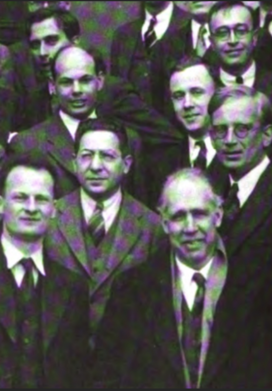
Wheeler's most celebrated student is, no doubt, Richard Feynman, who took his Ph.D. at Princeton in 1942. Feynman went on to win the Nobel Prize in Physics in 1965, and his recent memoirs, "Surely You're Joking, Mr. Feynman!", have become a best seller. In a chapter he calls "Monster Minds, " Feynman writes about the time that he showed his teacher a calculation which, upon inspection, Wheeler said must be wrong. Feynman writes, "What bothered me was, I thought he must have done the calculation. I only realized later that a man like Wheeler could immediately see all that stuff when you gave him the problem. I had to calculate, but he could see."
In addition to supervising students, Wheeler has done an incredible amount of original research. He has worked in the beginning stages of almost every branch of contemporary physics, from nuclear fission to black holes. Indeed, the terms " black hole," "ergo-sphere," "geon," "Planck length," and "stellerator" were all invented by him. A paper he wrote with Niels Bohr in 1939 was the first successful theoretical treatment of fission.
WHEELER traces his heritage in this country back to 17th-century New England. His father's side of the family migrated there with the "dissenters" from the southeast of England. His mother's side, the Archibalds, moved from Nova Scotia to Kansas just before the Civil War. His great-grandfather Archibald was one of the founders of Lawrence, Kansas, and his grandfather was nearly executed by Quantrill's Raiders-the Confederate "border bandits" under the command of William C. Quantrill." They lined my grandfather up in front of a barn door," Wheeler said, "and were about to shoot him. His mother threw herself in front of him and said, 'Don't shoot him. He's just a boy.'" After the war, this grandfather matriculated at the University of Kansas in Lawrence. He eventually taught school and ran a ranch in Trinidad, Colorado.
While Wheeler does not count any scientists among his ancestors, he told me that his grandfather Archibald taught him some mathematics. His mother, when standing in line in a grocery store, could see the figures upside-down on the sales receipt of a customer in front of her and add them in her head before the sales clerk could add them right- side-up. She used to walk a ten-mile round trip along the railroad tracks to school. When she was 18, she and her family moved to Washington, D.C.
Both Wheeler's parents were librarians, although his mother gave up her career after his birth on July 9, 1911. His brother Joe was born three years later, and Wheeler did most of his growing up in Youngstown, Ohio. There the family was completed by the addition of a brother, Robert, born in 1917 (a geologist until his death a few years ago), and a sister, Mary, born in 1918, who became a librarian and now lives in Vermont. Brother Joe also began a career in library work but was killed in World War II.
Wheeler's Ohio boyhood sounds like a happy one. He had a paper route delivering the Youngstown Vindicator and worked Saturday mornings in the library repairing books. Unlike many leading theoretical physicists, he does not have any special early mathematical memories. He does recall that when he was about four years old he asked his mother, who was bathing him at the time, "What happens when you get to the end of things?" I asked Wheeler if he had numbers in mind. "No," he said, “space. Questions without answer."
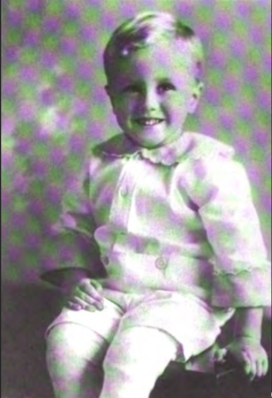
Most of Wheeler's early scientific memories have to do with making things: comptometers, wooden guns, and a railway signal. He also managed to blow off a small piece of a finger with a dynamite cap, an experience that left him with a slightly peculiar-looking finger and oddly enough a highly developed taste for explosives. To this day he enjoys firecrackers. These activities culminated at the age of 13, when he and his friend Verdette Moke established the " Wheeler-Moke Safe and Gun Company." It produced wooden combination locks.
The family moved to Baltimore when his father became director of that city's public library. By this time Wheeler had taught himself both differential and integral calculus and was working his way through the great Dutch physicist H.A. Lorentz's Problems of Modern Physics, which deals with both Einstein's theory of relativity and the quantum theory. At age 15, Wheeler completed his high school education at Baltimore City College, one of the best high schools in the city. He entered Johns Hopkins University the following year with the idea of becoming an engineer. "My three maternal uncles, " he explained, "were mining engineers. With my interests, how else was I going to earn a living except at engineering? The idea that you could do what you wanted and get paid for it never occurred to me."
The engineering phase of Wheeler's career lasted only a year, in part because the engineering library and the physics library were one and the same. While he was doing homework on the bending of beams and the like, he would sneak a glance at the latest issues of Zeitschriftfür Physik, where articles on the then- new quantum mechanics were being published. The teacher of his freshman physics course, John C. Hubbard, also encouraged him to consider " the physics side of life." As if the enticements of quantum mechanics were not enough, one of his uncles, John Archibald, got him a summer job in Zacatecas, Mexico, the site of the famous Mexican silver mines. A summer spent rewinding electric motors was enough to convince Wheeler that the life of a mining engineer was not for him.
Happily, Johns Hopkins had a six- year program that led directly to a Ph.D., so directly that there was no clear distinction between undergraduates and graduate students in the program. Indeed, although Wheeler has 12 honorary doctorates, he has no undergraduate degree. He earned his Ph.D. from Johns Hopkins in 1933. He did his thesis with Karl Herzfeld on the absorption and scattering of light in helium. Although Wheeler, always unassuming about his work, downplays the quality of his thesis, it and his other efforts were sufficiently impressive to earn him one of the very rare National Research Council Fellowships. He felt especially fortunate to receive it because “this was the depth of the Depression. Well-dressed people came to the door asking for any kind of job—painting, mowing the lawn, shoveling coal—anything. Desperate years.”
Wheeler had his choice of working with J. Robert Oppenheimer in California or Gregory Breit at New York University. He chose the latter. “Oppenheimer was much quicker than I was accustomed to,” Wheeler says. “Breit was a slower thinker. I have to ponder and ponder on things so his style fitted me. I learned a lot of physics with him that year.”
He also got engaged—after three dates—to Janette Hagner, whom he had met at a dance in Baltimore. A Radcliffe graduate, she had done postgraduate work in Italian history at Johns Hopkins before teaching at the Rye Country Day School outside. New York. But the couple did not get married for a year and a half. Wheeler went to Copenhagen.
Every scientist-Einstein being a notable exception-can find in his or her career a decisive teacher. For Feynman, it was Wheeler. For Wheeler, it was to be Bohr, who had won the Nobel Prize in 1922 for his concept of the structure of the atom. His lab in Copenhagen had become the mecca of international physics, and Wheeler wanted to study there because as he wrote on the application to extend his fellowship-Bohr “sees further ahead than any man alive.” A teacher at NYU told Wheeler, who was only 22, that he should wait to go to Copenhagen until he was a “mature physicist.” With Breit's encouragement, however, Wheeler applied anyway. He was accepted.
When Wheeler met Bohr, the older man was 49. He had, Wheeler told me, “two speeds not interested or completely interested. The thing he was completely interested in then was whether electrodynamics was right at high energies.” Oppenheimer thought not. “Before I had come to Copenhagen, I had listened to an absolutely packed evening lecture by Oppenheimer where he had said that electrodynamics must surely fail when the energies get to be about 137 electron masses. But Bohr and E.J. Williams, who was also in Copenhagen, had developed a point of view from which you could deduce that it could not break down. Williams was able to take advantage of a cross-section I had worked out with Breit for the production of an electron position pair in the field of a nucleus. I remember talking to Bohr and Williams. I was so shy that I got up to erase the board with the back of an eraser. Bohr turned it over and said, ‘It would be easier if you did it this way.’”
About this time, Bohr's interests switched to nuclear physics and he developed what has become known as the “liquid drop model” of the atomic nucleus. In this model the nucleus is treated like a tiny globule of an incompressible fluid. One does not attempt to treat the individual nucleons in the nucleus but only their collective behavior. The model has been enormously successful in treating nuclear reactions and, almost at once, Wheeler began applying it.
He was also writing “to any place that I had ever heard of” for a job, and wound up at the University of North Carolina in Chapel Hill as an assistant professor. “It paid, I think, $2,300 a year,” Wheeler told me. “Janette gave up her job, which paid $2,500, and came with me to Chapel Hill. When I look back on it, it was the craziest thing for us not to have gotten married before I went to Denmark.” The Wheelers celebrated their 50th anniversary this year.
Wheeler had every intention of remaining in Chapel Hill forever. His two elder children, Letitia Wheeler Ufford and James English Wheeler, were born there in 1936 and 1939 respectively. (His younger daughter, Alison Wheeler Lahnston, was born in Baltimore in 1942.) In 1938, however, Wheeler was offered a position at Princeton. The distinguished theoretical physicist Edward Condon had just left for the Bureau of Standards in Washington, and the university decided to replace him with two nuclear theorists, Eugene Wigner and Wheeler. A program of experimental nuclear physics with Rolf Ladenburg and Milton White had also gotten under way at the university.
Wheeler was no stranger to Princeton. He had visited there in 1933 to hear Einstein's first lecture after his arrival from Germany. Wheeler commented, “Einstein was not the kind of retail dealer in equations I was accustomed to. He was a wholesale dealer. He was counting them by the dozens.” Then he had returned in 1935 for a three-month visit to the Institute for Advanced Study. “My wife wept when we left Chapel Hill,” Wheeler recalled, “but then she practically wept again when, in 1976, we left Princeton for Texas.”
ON JANUARY 16, 1939, Bohr arrived aboard the Swedish ship Drottingholm with the knowledge that the nucleus had been split. Fission had been discovered the month before by two German scientists, Otto Hahn and Fritz Strassman. (It could well have been discovered several years earlier by Fermi or Joliot-Curie, Wheeler thinks, or even predicted theoretically by Bohr.) Hahn and Strassmann, however, did not understand the significance of their experiments until it was explained to them by their former collaborator Lisa Meitner, who had fled to Sweden with her nephew, the physicist Otto Frisch. Frisch was the actual inventor of the word “fission.”
Bohr had decided to say nothing about fission until he could be sure that Meitner and Frisch would get proper credit. However, he had come on the ship with his son Eric and his collaborator Leon Rosenfeld. Fermi and his wife, who had just fled from Italy to the United States, were also on the pier and they took Bohr and his son to New York for the evening while Wheeler took Rosenfeld to Princeton.
“At that time,” Wheeler remembers, “I had a major part in running the Monday night journal club. It began, as a rule, at 7:30; we deliberately had too few chairs so people would arrive promptly to get a seat. It was necessary to break up just a little before 9:30 because a lot of people wanted to go to the second show at the movie theater. We usually had three speakers and I got Rosenfeld to give one of the talks. He didn't realize that he was not supposed to talk about fission. He spilled the beans and of course everybody was immensely excited. Bohr came to Princeton the next day and, somehow, we just naturally began a collaboration on it.”
While they were developing their theory based on Bohr's liquid drop model-the drop split into two or more droplets either spontaneously or after being perturbed from the outside by a projectile like a neutron experimenters from Princeton and elsewhere were making new discoveries about fission almost daily. The most paradoxical one, the one that Bohr fastened onto, was the fact that slow neutrons would cause uranium to fission, as would fast neutrons, while neutrons of intermediate energy would not. Bohr, Wheeler told me, had the inspired idea that slow-neutron fission must be caused by the rare isotope U235, while fast- neutron fission is largely caused by the common isotope U238.
This extraordinary intuitive guess, which turned out to be correct, led to one of the two ways of constructing an atomic bomb — namely separating the U235 from the U238 to make a pure explosive mass of U235. The other way, proposed a little later by Louis Turner, was to convert U238 into a new element, soon to be called plutonium, which was also fissionable by slow neutrons.
The idea that U235 and not U238 was responsible for slow neutron fission seemed crazy to most of Wheeler's contemporaries. He recalls making a bet of $18.36 to a penny with his colleague George Placzek that it was true. (The strange looking ratio is essentially the ratio of the proton to electron mass.) Later Placzek sent a one-word telegram- “Congratulations!” - along with a money order for one cent.
Wheeler has several vivid memories of his collaboration with Bohr. One night, at about 10 o'clock, they went to the library to see if they could find some synonym for “fission.” “The word ‘fission’,” Wheeler Bomb advocate Eugene Wigner said, “was great as a noun, but we didn't like it as a verb. We tried ‘splitting’ or ‘mitosis’ but they didn't seem any better, so finally we used ‘fission.’” Along with many of Bohr's other traits, this sort of musing over the right word still characterizes Wheeler.
Wheeler also recalls a Fine Hall janitor for whom fission ran a distant second to keeping the offices neat. “He scolded Bohr for spilling chalk on the floor,” Wheeler remembers. “After that, when he finished working, Bohr would always pick up the rug and kick the chalk under it.”
Bohr had a very intense way of speaking, Wheeler continues. “He would say, ‘How can you possibly imagine such and such to be the case?’ His eyes would be almost vertical instead of horizontal. At other times, when he was undecided, he would talk about one position with his head turned one way, and the other position with his head turned the other way. He was always ready to reconsider everything.”
I asked Wheeler if he had a sense of something portentous in working on fission. “I should have, but I didn't,” he answered. “I think it was March 16th two months to the day after Bohr had arrived in New York-that we had a meeting in Wigner's office, the office in Fine Hall that had been Einstein's. There were four or five of us: Bohr, Wigner, [ Leo] Szilard, and myself. We talked about using fission for submarines and for making a bomb. Bohr said that using U235 to make a bomb would require the resources of an entire nation. In the end it took three.
“I was not as worked up about it as were Szilard and Wigner. I had the mistaken idea, based on what had happened in World War I, that we would stay out. I felt that Germany would win any war in Europe and that as terrible as Hitler was, there was a German culture which one could hope would come back. It is very unfortunate that I felt like that. If I had been more convinced, as Wigner and Szilard were, that we were going to get into the war, I would have pushed harder to begin making the bomb.
“I figured out that roughly a half-million to a million people were being killed a month in the later stages of the war. Every month by which we could have shortened the war would have made a difference of half a million to a million lives, including the life of my own brother. If somebody had pushed the project harder in the beginning, what a difference it would have made in the saving of lives.” At the time, though, he thought of this work in nuclear physics as “a temporary thing—an interlude before I got back to more fundamental questions.”
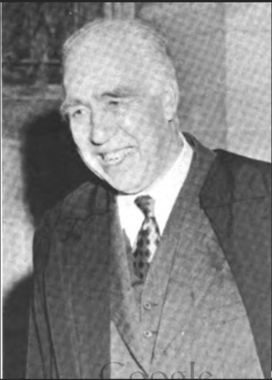
Wheeler's return to fundamental physics was aided by Feynman's arrival at Princeton in 1939. Only seven years younger than Wheeler, Feynman had been an undergraduate at M.I.T., where he was well known both for his brilliance and his sundry capers. He began at Princeton by grading papers for Wheeler, but before long the two were friends, and they began collaborating on more or less equal terms.
Feynman, Wheeler told me, had all kinds of special interests. Once he allowed himself to be hypnotized by someone giving a lecture on the subject. Another time he became interested in jellyfish. It seems that a jellyfish has a single nerve that goes entirely around it. Feynman became exercised by the question of why, if the jellyfish is touched, it doesn't keep vibrating forever, since the nerve impulse would go around and around. Biologists had proposed that there were two nerve impulses moving in opposite directions which, once they met, would cancel each other out and arrest the vibrations.
“Somehow,” Wheeler remembers, “the boys worked out a way to cancel one of the impulses, and the unfortunate jellyfish did vibrate hour after hour. Feynman used to come over to our house to work, or for supper. As my wife was cooking supper, he would explain to our two very young children how you could tell whether the contents of a can were liquid or solid by the way it would go when you tossed it up in the air.”
Wheeler gave a classical mechanics course for which Feynman took the notes. Feynman generalized these classical ideas. and, in his Ph.D. thesis, presented a novel formulation of quantum mechanics which has been the basis of much current work. Wheeler was so taken by these ideas that he went to Einstein, who disliked the quantum theory, to see if the new formulation might change his mind. " Einstein listened patiently for 20 minutes, " Wheeler remarked, and I ended up by saying, ' Doesn't this look perfectly beautiful? Doesn't this make you willing to accept the quantum theory?' He said, ' I still cannot believe that God plays dice. But maybe I have earned the right to make my mistakes. ' After Pearl Harbor, there was no longer any question about Wheeler's getting involved full time in the war. He went to the chairman of the Physics Department and said that if he were not granted a leave of absence to go to the University of Chicago to work on the first reactor, he would have to resign. He was granted a leave.
BECAUSE OF his engineering background Wheeler was able, from the beginning, to act as a bridge between the physicists working with Fermi to create the first self-sustaining, chain-reacting nuclear pile, and the professional engineers who had been brought in as consultants.
For this reason, Wheeler thinks, he was first assigned to be the liaison between the Chicago project and the Du Pont company, which had the responsibility for constructing the first plutonium production reactors.
On Thanksgiving Day 1942, the Fermi reactor in Chicago went critical. I asked Wheeler if he had been there to see it. “No,” he said. " I was in Wilmington with the Du Pont people. I really wasn't interested in a reactor demonstration. To me it was obvious that it would work.”
One of the next problems, and one that Wheeler was called upon to help solve, was where to put the first plutonium - producing plant. Various sites were considered and ruled out. Florida, for example, was out because it had more thunderstorm days per year than any other place in the country. Finally, the plant was sited on the Columbia River in the state of Washington, largely because the place was isolated and had pure water (essential as a cooling agent for the reactor). The plant, in the city of Richland, was called the Hanford Engineering Works, and Wheeler moved his family there in July 1944.
In time, the place had some 50,000 workers-mostly, Wheeler told me, “Oakies” and “Arkies.” When they got off the train in Richland, they were met by “wolves” (people who wanted to separate them from their money) and “sheepherders” (who made sure they got to the plant intact). There was a beer hall, which Wheeler said featured about one murder per night and had windows built low enough that tear gas could be thrown in to calm any excessive exuberance.
Wheeler's job was to think of everything that might go wrong. How much radioactivity would go downstream in the river? What kinds of surges in temperature might be expected? And on and on. Feynman had gone to Los Alamos where, among many things, he had figured out how much liquid plutonium was needed to make an explosive mass-a very small amount, as it turned out. (Handle with care, Wheeler inferred. Safety precautions were stepped up at the Hanford Works.) Wheeler visited Los Alamos from time to time and, he said, “My friends, knowing my proclivity for big bangs, would take me out on the mesa at night when they made their high explosive tests.”
At 12:01 a.m. on September 27, 1944, the Hanford pile was allowed to start producing power at something like full strength. This was to be a moment of triumph and many dignitaries were on hand, including Fermi. Wheeler, who was in the central laboratory computing various things, began getting very disturbing reports. When the safety rods were first pulled out of the reactor, the reactivity climbed, as it should have done. But then, mysteriously, reactivity began to fall. Even with the rods completely pulled out, the pile (in Wheeler's words) " died to death. "
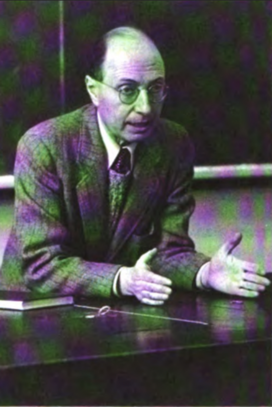
"Everybody was scurrying around," Wheeler noted. What could be wrong? One theory was that nitrogen from the air had gotten fixed in the pile and was absorbing the neutrons. Or perhaps there was something in the water. " But it had been one of my jobs to consider every possible way that things might go wrong. I was, therefore, very aware that a fission product, when it decayed, could give rise to another one which could absorb the neutrons. When, a few hours later, the reactivity began rising again, I was sure this was what had happened. Now the second nucleus had decayed into a third one which did not absorb the neutrons. " Looking at a chart of nuclei, Wheeler could see that " the culprit had to be xenon- 135."
"The hero of the story," added Wheeler, "was a Du Pont engineer named George Graves. He kept asking questions like, 'What in the hell are fission products?' Once he got into it, he insisted that instead of the 1,500 fuel tubes we had planned, we have a margin for error of another 500- actually we had 2,004. That decision took a lot of gumption, since it cost a lot of money. But thanks to his foresight it was possible to reload those extra tubes with uranium and give the pile the reactivity it needed to override the fission product poison. "
The Hanford plant was the only one in the U.S. that was shut down because of enemy action. The Japanese wafted paper balloons with incendiary bombs across the Pacific. Some of them set fires in the Pacific Northwest, and one draped itself around the power lines that fed the water pumps to the pile and put it out of commission. That incident, kept completely secret during the war, caused a great deal of nervousness on the project. Wheeler recalls that, a few days later, he was walking from lunch when a colleague pointed to the sky and said he thought he saw a balloon. After a good deal of frantic peering, they realized they were seeing the planet Venus.
WHEELER had enough contact with Los Alamos to know about the Trinity test of the atomic bomb on July 16, 1945. Once that had succeeded, he felt that the war would be over soon, so he and his family moved back to Princeton. There he was instrumental in setting up a new cosmic ray laboratory, a relatively inexpensive way to study the newly discovered elementary particles. As an expert on the safety aspects of reactors, he also did a good deal of advising and consulting. He is one of the people responsible for having safety domes built over reactors to hold in fission products in case of an accident.
In October 1949, Wheeler told me, he met with his British counterparts to discuss reactor safety. He described to them the improbability ofthe reactor's multiple safety defenses being penetrated and, as an afterthought, discussed the question of deliberate sabotage. "I said, " Wheeler recalled, " that someone who would do this had to be completely trusted, technically very good, and motivated by some strange ideology. As I was speaking, Klaus Fuchs was listening to me across the table. A month later he was in jail for spying at Los Alamos.
"Two or three years ago, Sir Rudolf Peierls, who had been responsible for bringing Fuchs into the bomb project, told me that when he read in the newspaper that Fuchs was in prison, he went immediately to see him. He said to Fuchs, ‘There's some terrible mistake. We've got to get proper legal counsel for you.’ Fuchs said, ‘No, there's no mistake. I was a spy.’ Peierls said, ‘How could you?’ ‘Well, I meant to give control of the world to the Russians.’ ‘But how could you?’ ‘Well, then I meant to tell them what was wrong with them.’”
In 1979, the year of the Einstein Centennial, Wheeler gave 18 Einstein lectures in eight countries. One of them was in East Germany. "It was very strange compared to the others. It was restricted only to important figures-the prime minister and the like. Among the list of notables, I noticed Fuchs . I asked an East German colleague if, during the coffee break, he would be willing to bring Fuchs over. When he came, I was careful to have my notebook in one hand and a coffee cup in the other. I didn't want to shake hands with him. We talked for about five minutes about the East German nuclear power program that he was busy with."
In 1949, Wheeler was awarded a Guggenheim Fellowship. He went to Paris so his children could learn French, and he commuted every couple of weeks to Copenhagen to see Bohr. At this time, a secret debate was raging within the U.S. government about whether to begin a crash program to build the hydrogen bomb. Wheeler was, as he told me, “minding his p’s and q’s in Paris.” He hoped to stay with fundamental physics now. But he has a sense that Europe was fragile.
“It seemed to me,” he said, “like a house of cards which a wind from the east could blow down. At any rate, the phone started ringing in the pensione where we were living in Paris; people from the Atomic Energy Commission in Washington were putting the heat on me to go to Los Alamos and take part in the H-bomb enterprise. I certainly didn’t want to do it. I held off the decision until I could go to Copenhagen to talk to Bohr. I was staying at his house. One day at breakfast I told him of the struggle I was having with my conscience about going back to Los Alamos. It was not his way to advise a person directly, but I can never forget a phrase he used: ‘Do you imagine for one moment that Europe would now be free of Soviet control if it were not for the bomb?’ That was enough to tip the scales.”
Wheeler returned to Los Alamos but found after eight months that too few physicists were willing to go there to work on bombs. He thought he would have a better chance of recruiting people if he could set up a branch of the project in Princeton. H was able to get the use of some grounds and buildings that had been abandoned by the Rockefeller Institute for Medical Research. There he established what eventually became the Forrestal Campus. Lyman Spitzer *38 had agreed to help with the task and, because of his mountaineering interests, named it Project Matterhorn. He originally intended to work on the bomb but, while skiing in Aspen, he hit on an idea for making power by using nuclear fusion in a controlled manner. It was this device that Wheeler named the Stellerator, the forerunner of today’s most promising proposal for producing fusion power—Tokamak.
As a result, the Matterhorn project split in two: Matterhorn A and B. Under Wheeler’s direction, B engaged in bomb design. He wrote, phoned, or visited about 120 scientists attempting to recruit them. Very few senior people wanted to return to weapons work, but he did manage to enlist some younger people. Then after Edward Teller and Stanislas Ulaw got the idea that finally made the American bomb possible, it feels to Wheeler and his people to do many of the basic calculations. Computing facilities being what they were, it sometimes took 36 hours on the machines to carry out some of the work. It was these computations that persuaded Oppenheimer that the new design was, in his indelible phrase, “technically sweet.”
I asked Wheeler if he felt that our work on the hydrogen bomb was really necessary. If the U.S. had not built one, would the Soviets have? He pointed out that the Russians exploded their hydrogen bomb nine months after ours, which meant that they must have been working on it while our own debate was going on. Wheeler witnessed our first test on November 1, 1952, in the Pacific. It was the largest we ever made, though some of the Soviet above-ground tests have been bigger. The fallout from these was one of the reasons both countries stopped testing above ground.
Even before he had finished with the Matterhorn project, Wheeler was anxious to get back to teaching and fundamental physics, and he has since written some half-dozen books and innumerable articles on Einstein’s theory of relativity and its implications for gravity. Wheeler was one of the first physicists to take the concept of black holes and other such outré gravitational phenomena seriously. For him they were not just interesting speculations, but real possibilities for entities in a physical world.
It was the context of gravity that, at a conference in 1967, Wheeler coined the term “black hole.” Up to that time he had been using locutions like “completely collapsed gravitational object.” Curiously, in the same September 1939 issue of the Physical Review in which the Bohr-Wheeler paper on fission appeared, there also appeared the seminal article by Oppenheimer and his student Hartland Snyder showing that objects—stars, for example—with masses greater than a certain characteristic amount would continue to collapse without limit, being sucked into themselves by the strength of their own gravitational fields. This result of such a collapse, of course, is today called a black hole.
Be that as it may, Wheeler’s first serious contact with the subject that he has made so much his own—gravitation and relativity—did not come, surprisingly, until 1952, when he taught a course on it at Princeton. At the end of the year Einstein invited Wheeler to bring his students to tea. (When one of them asked Einstein what would happen to his house after his death, Einstein replied that it would never become a place for pilgrimages where the pilgrims “come to look at the bones of the saint.”) Wheeler’s students from his relativity period at Princeton now populate the facilities of universities all over the country.
I recall attending a small conference of theoretical physicists at the Institute for Advanced Study in Princeton in the spring of 1968, the year after Oppenheimer died. The conference was in his memory. After some of the more conventional speakers had given their talks, Wheeler was called on to discuss his latest speculations on black holes. I think it is fair to say that the attitude toward them was very skeptical. One of the things he told us about is what he picturesquely called the “no-hair theorem.” This is the idea that when matter or anti-matter disappears down a black hole, it leaves very few traces. In particular, there is, at least in the context of classical physics, no way of telling whether what has disappeared is matter or anti-matter. No one then at the meeting seemed to have much interest in this except Freeman Dyson, who, as I recall, commented that this was physics we would eventually grow into. He was right. Wheeler's ideas of that time, such as the no- hair theorem, which seemed so far-out then, are now in the mainstream of the very active field of gravitational physics.
Wheeler has, of course, moved ahead. His new work, which involves such things as “super space,” a space in which each point is itself a space, is beyond my capacity to evaluate. In this kind of scientific speculation I see him as the sort of modern abstract artist in whom one has special confidence because one knows that he is a brilliant draftsman if and when he wants to be. He has “paid his dues.” He has shown that when he wants or needs to be, he can do the most mundane and specific kind of engineering imaginable, as he did with reactors. He does very abstract and often peculiar- looking speculation, not because he cannot do more specific physics, but because the specific physics problems that exercise so many of his colleagues seem to him to avoid what he sees as the really fundamental problems. Perhaps once again we will grow into his new ideas.
It had been Wheeler's intention to live out his professional life at Princeton. He had had other offers but had always turned them down. In 1976, however, the University of Texas offered him a position too good to refuse. The inducement was not financial-Wheeler is on half-salary-but the fact that Texas, unlike Princeton and most other universities, had no formal retirement age. For Wheeler, life without students is intolerable. He once said to me, “As far as I am concerned, graduate students are the number one way of advancing. How can you fight any battle unless you fight it alongside your graduate students?”
Part of his arrangement with Texas, then, includes money for students. During the first four years he was in Austin, he organized a conference for undergraduates from the U.S., Canada, and Mexico something he calls “recruiting through resonance.” The conferences attracted outstanding students, some of whom he persuaded to come to Austin. Wheeler is very pleased with the caliber of the present students and faculty. He also likes the relaxed Texas lifestyle. During my visit he led a group of us to Colonel Quackenbush's, a student hangout. There, over cappuccino, we had a vigorous discussion of the latest in physics.
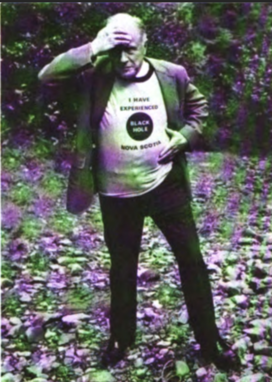
FOR A PHYSICIST of his eminence, Wheeler has had relatively little involvement in government affairs. His abiding interest is finding out how the laws of nature are put together on the deepest level. These concerns have philosophical and metaphysical overtones, and therefore his articles for the general public often sound philosophical and metaphysical. After reading something of Wheeler's, Dyson once commented that it sounded like Beowolf.
This metaphysical tone has given some aid and comfort to writers whom one might classify as “quantum Buddhists.” For example, in The Dancing Wu Li Masters, Gary Zukav quotes the following from Wheeler: “May the universe in some strange sense be brought into being' by the participation of those who participate? ... The vital act is the act of participation. 'Participator' is the incontrovertible new concept given by quantum mechanics. It strikes down the term ' observer' of classical theory, the man who stands safely behind the thick glass wall and watches what goes on without taking part. It can't be done, quantum mechanics says. " To this Zukav adds, " The languages of Eastern mystics and Western physicists are becoming very similar.”
Wheeler is not entirely comfortable with the juncture of physics and mysticism. Several years ago he became extremely annoyed, at a meeting of the American Association for the Advancement of Science, when he was put on the same program with three parapsychologists. In fact, he prepared and handed out at the meeting a strong statement which said, in reference to parapsychology, "Where there's smoke, there's smoke. " At the same time, he is a man of wide open mind and unfailing courtesy. Like his teacher Bohr, he likes to think of a problem first in one way, then in another. It is nearly impossible to state a physical idea in which he can find nothing of interest. So I asked him, not so much about his reaction to Zukav's book—which he said he has not read but about the philosophical role of quantum mechanics in general. As far as I had been able to tell from Wheeler's course at Columbia, he is an orthodox quantum mechanician directly in the tradition of Bohr.
“Yes,” he said, “in that course I was just trying to state what quantum mechanics is as clearly as possible. The phrase, ‘No elementary quantum phenomenon is a phenomenon until it's a registered phenomenon,’ that is to say brought to a close by an irreversible act of amplification that is the essence of it. I am, however, still puzzled by elementary quantum phenomena that are not put to use, the flash on a zinc- sulfide screen on some faraway planet where there is no life. It's just part of the grand mass of collisions between electrons and atoms that goes on all the time, all over the place. It doesn't rate any special claim. There's no heavenly choir that's clapping its hands at having that happen. I am just driven crazy by that question.
“I confess that sometimes I do take 100 percent seriously the idea that the world is a figment of the imagination and, other times, that the world does exist out there independent of us. However, I subscribe wholeheartedly to those words of Leibniz: ‘This world may be a phantasm and existence may be merely a dream. But,’ he went on to say, ‘this dream or phantasm to me is real enough if using reason well we are never deceived by it.’”
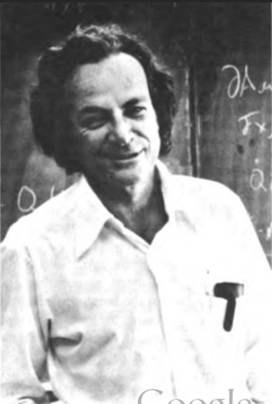
“Yet,” Wheeler added, “we’re not content with merely uttering words about reality. We want to see the machinery taken apart. And, by George, we’re so far from taking the machinery apart, just unbelievably far. For example, we feed in dimensions—four dimensions, six dimensions, ten dimensions, eleven dimensions—as if at the bottom of things there is any dimensionality at all. There can’t be. A dimension must be derived from some point of view, some way of doing physics, some overall picture in which dimensionality, in the beginning, does not even start to enter. Time. Why is there any such thing as time? Time cannot be fundamental. The ideas of before and after fail at very small distances. They fail at the big bang. Why is the quantum there? If you were the Lord of building the universe, what would convince you we couldn’t make a go of it without the quantum? In our work in physics, we take the quantum theory as a given. It’s a sausage grinder. We drop out problems and turn the crank and get out the answers. Where did the sausage come from?”
Wheeler smiled and concluded, “It’s such an exciting thing to be in physics. I must say that every day when I wake up it’s such a miracle. Why should there be any world here? It’s incredible. What’s the explanation for it? It must be absolutely beautiful, absolutely simple. And how stupid we are not to see it. So I feel desperate trying to find a clue all the time.”
This was originally published in the October 9, 1985 issue of PAW.


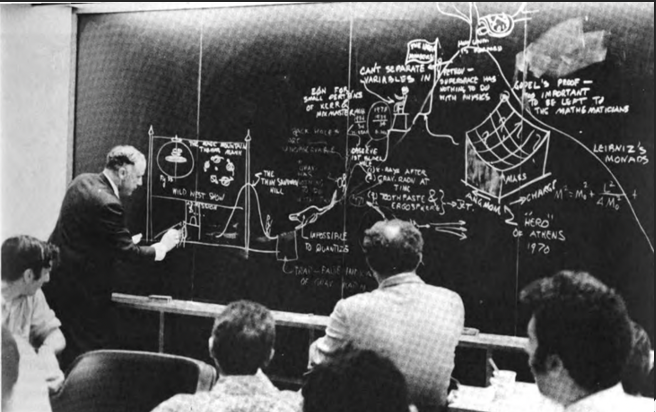
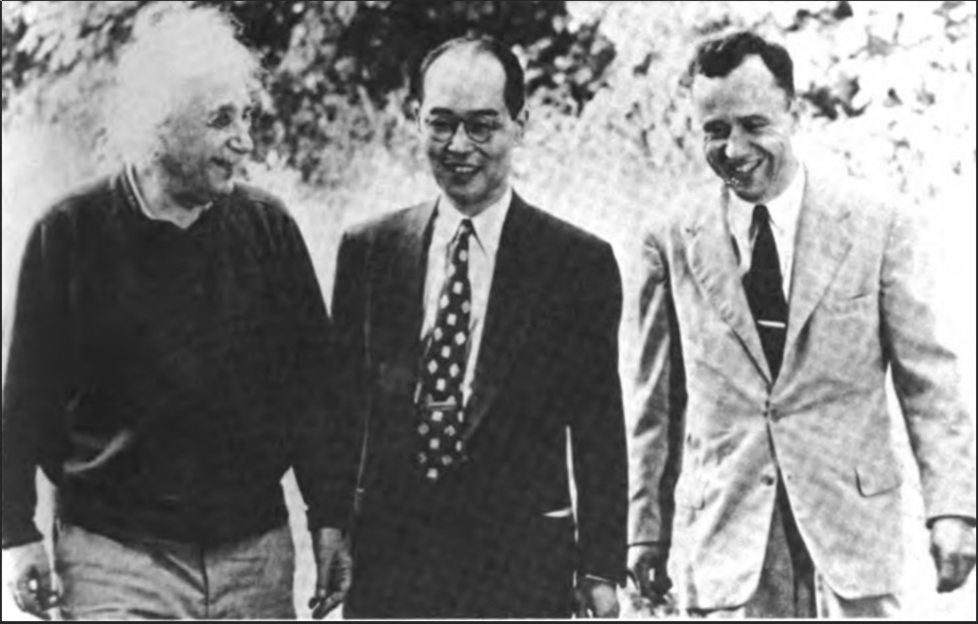









No responses yet